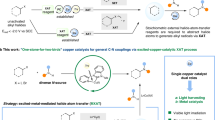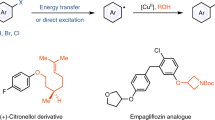Abstract
THE introduction of copper (II) salts into most commonly used flames gives a green emission. Copper halides give a particularly intense emission, which is used in the well-known Beilstein test for halogens. The spectra from all copper salts, however, are very similar, and consist mainly of diffuse CuOH bands in the region 535–555 nm, a CuH band centred around 429 nm, CuO emission bands between 445 and 492 nm and a copper atom line at 327 nm (ref. 1, and Fig. 1). Copper (I) halide bands are also present when copper (II) halides are used, but are weak. The enhanced emission of the halides, therefore, arises mainly from their great volatility and consequent enhanced production of exited CuOH, CuO and CuH molecules, rather than greatly enhanced production of copper (I) halide emission. For this reason, pseudohalides such as cyanide and thiocyanate ions also give positive Beilstein tests. The copper (I) chloride emission that has been observed in flames, especially when they are very fuel lean2, is very insensitive for use in analysis.
This is a preview of subscription content, access via your institution
Access options
Subscribe to this journal
Receive 51 print issues and online access
$199.00 per year
only $3.90 per issue
Buy this article
- Purchase on SpringerLink
- Instant access to full article PDF
Prices may be subject to local taxes which are calculated during checkout
Similar content being viewed by others
References
Pearse, R. W. B., and Gaydon, A. G., The Identification of Molecular Spectra (Chapman and Hall, London, 1963).
Honma, M., Analyt. Chem., 27, 1656 (1955).
Belcher, R., Bogdanski, S. L., and Townshend, A., Analytica chim. Acta, 67, 1 (1973).
Salet, G., C.r. hebd. Séanc. Acad. Sci., Paris 68, 404 (1869); 73, 559 (1871); 74, 865 (1872).
Author information
Authors and Affiliations
Rights and permissions
About this article
Cite this article
BELCHER, R., BOGDANSKI, S., GHONAIM, S. et al. Production of copper(I) halide emission spectra by MECA. Nature 248, 326–327 (1974). https://doi.org/10.1038/248326a0
Received:
Revised:
Published:
Issue date:
DOI: https://doi.org/10.1038/248326a0
This article is cited by
-
Element-specific determination of chlorine in gases by Laser-Induced-Breakdown-Spectroscopy (LIBS)
Fresenius Journal of Analytical Chemistry (1996)



